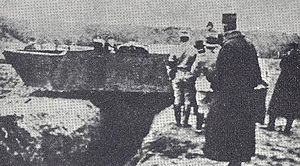
An armoured fighting vehicle or armored fighting vehicle (AFV) is an armed combat vehicle protected by armour, generally combining operational mobility with offensive and defensive capabilities. AFVs can be wheeled or tracked. Examples of AFVs are tanks, armoured cars, assault guns, self-propelled artilleries, infantry fighting vehicles (IFV), and armoured personnel carriers (APC).

A military armoredcar is a lightweight wheeled armored fighting vehicle, historically employed for reconnaissance, internal security, armed escort, and other subordinate battlefield tasks. With the gradual decline of mounted cavalry, armored cars were developed for carrying out duties formerly assigned to light cavalry. Following the invention of the tank, the armored car remained popular due to its faster speed, comparatively simple maintenance and low production cost. It also found favor with several colonial armies as a cheaper weapon for use in underdeveloped regions. During World War II, most armored cars were engineered for reconnaissance and passive observation, while others were devoted to communications tasks. Some equipped with heavier armament could even substitute for tracked combat vehicles in favorable conditions—such as pursuit or flanking maneuvers during the North African Campaign.

A tank is an armoured fighting vehicle intended as a primary offensive weapon in front-line ground combat. Tank designs are a balance of heavy firepower, strong armour, and good battlefield mobility provided by tracks and a powerful engine; usually their main armament is mounted in a turret. They are a mainstay of modern 20th and 21st century ground forces and a key part of combined arms combat.

Continuous track or tracked treads are a system of vehicle propulsion used in tracked vehicles, running on a continuous band of treads or track plates driven by two or more wheels. The large surface area of the tracks distributes the weight of the vehicle better than steel or rubber tyres on an equivalent vehicle, enabling continuous tracked vehicles to traverse soft ground with less likelihood of becoming stuck due to sinking.

The history of the tank begins with World War I, when armoured all-terrain fighting vehicles were introduced as a response to the problems of trench warfare, ushering in a new era of mechanized warfare. Though initially crude and unreliable, tanks eventually became a mainstay of ground armies. By World War II, tank design had advanced significantly, and tanks were used in quantity in all land theatres of the war. The Cold War saw the rise of modern tank doctrine and the rise of the general-purpose main battle tank. The tank still provides the backbone to land combat operations in the 21st century.

The Schneider CA 1 was the first French tank, developed during the First World War.

The Saint-Chamond was the second French tank to enter service during the First World War, with 400 manufactured from April 1917 to July 1918. Although not a tank by a strict definition of a heavily armoured turreted vehicle, it is generally accepted and described as such in accounts of early tank development. It takes its name from the commune of Saint-Chamond where its manufacturers Compagnie des forges et aciéries de la marine et d'Homécourt (FAMH) were based.
Jean Baptiste Eugène Estienne was a general of artillery and a specialist in military engineering, one of the founders of modern French artillery and French military aviation, and the creator of the French tank arm. He is considered by many in France to be the Père des Chars.
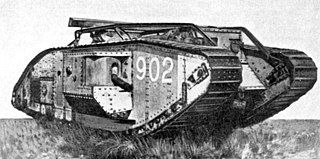
The development of tanks in World War I was a response to the stalemate that developed on the Western Front. Although vehicles that incorporated the basic principles of the tank had been projected in the decade or so before the War, it was the alarmingly heavy casualties of the start of its trench warfare that stimulated development. Research took place in both Great Britain and France, with Germany only belatedly following the Allies' lead.
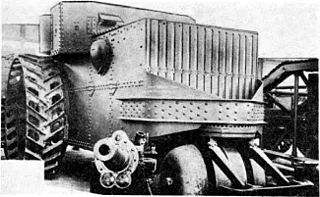
The Steam Wheel Tank was a U.S.-produced, prototype armoured fighting vehicle built by the Holt Manufacturing Company. Developed sometime between late 1916 and early 1917, it was the third tank to be designed in the U.S. The prototype was completed in February 1918 and was evaluated between March and May 1918 at Aberdeen Proving Ground. It performed poorly and was not developed further.
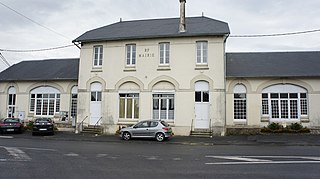
Souain-Perthes-lès-Hurlus is a commune in the Marne department in north-eastern France.

An armoured personnel carrier (APC) is a broad type of armoured military vehicle designed to transport personnel and equipment in combat zones. Since World War I, APCs have become a very common piece of military equipment around the world.
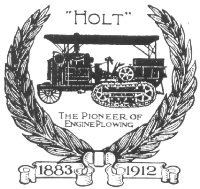
The Holt Manufacturing Company began with the 1883 founding of Stockton Wheel Service in Stockton, California, United States. Benjamin Holt, later credited with patenting the first workable crawler ("caterpillar") tractor design, incorporated the Holt Manufacturing Company in 1892. Holt Manufacturing Company was the first company to successfully manufacture a continuous track tractor By the early 20th century, Holt Manufacturing Company was the leading manufacturer of combine harvesters in the US, and the leading California-based manufacturer of steam traction engines.

The Frot-Laffly armoured roller, also Frot-Turmel-Laffly armoured roller, was an early French experimental armoured fighting vehicle designed and built from December 1914 to March 1915.

The Boirault machine, was an early French experimental landship, designed in 1914 and built in early 1915. It has been considered as "another interesting ancestor of the tank", and described as a "rhomboid-shaped skeleton tank without armour, with single overhead track". Ultimately, the machine was deemed impractical and was nicknamed Diplodocus militaris. It preceded the design and development of the English Little Willie tank by six months.

The Levavasseur project was an early project for a tank designed in 1903 by the French Captain Léon René Levavasseur (1860-1942) of the 6th Artillery Battalion, described as a "self propelled cannon project". It is considered as the first description, made by a soldier, of what would come to be known as the tank. Levavasseur was a graduate of Ecole Polytechnique, of the promotion of 1881. According to Armoured Fighting Vehicles of the World:
A project for a vehicle which had all the characteristics later thought desirable in a tank was put forward to the French War Ministry as early as 1903. Devised by a Captain Levavasseur of the 6th Artillery Battalion, who called it a "canon autopropulseur", the vehicle was envisaged as carrying a 75mm gun mounted in a box-like steel caisson which ran on crawler tracks, or "roues articulées" as Levavasseur called them. Powered by an 80hp petrol engine, the Levavasseur machine would have had a crew of three, storage for ammunition, and a cross-country ability.

The Breton-Prétot machine was an experimental wire-cutting device developed in France from November 1914. It was developed by Mr. Prétot, engineer, and Jules-Louis Breton, member of the French National Assembly.

The Holt tractors were a range of continuous track haulers built by the Holt Manufacturing Company of Stockton, California which were named after company founder Benjamin Holt.
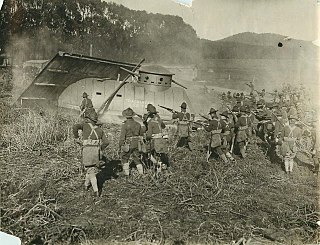
The CLB 75 Tank was a U.S.-produced, prototype armoured fighting vehicle built by C. L. Best's Traction Company of San Leandro, California. Best was a rival of the Holt Manufacturing Company in producing caterpillar tracked vehicles. Among Best's products was the CLB 75 hp (56 kW) 'Tracklayer' The tank was developed by putting an armoured hull over a CLB 75 sometime between late 1916 and early 1917.
